The Grand River, Michigan’s longest waterway, stretches 262 miles from Jackson to Lake Michigan. This road of water has been the lifeline of commerce and transportation for over 10,000 years. Come along with us from Jenison to Grand Haven as we explore this entrancing river, the river boats and the landings along its banks.

as we backed Loki, our freighter canoe, into The Grand River.
For centuries this river had been known as the “Owashtenong,” which means ‘the far away water.’ The area bands of native people, Anishinaabe, had belonged to tribes: Ottawa (Odawa), Chippewa (Ojibwe) and Potawatomi (Bodewadmi). Our state’s name of Michigan had been derived from “Mishigamaw” which means ‘Great Water.’
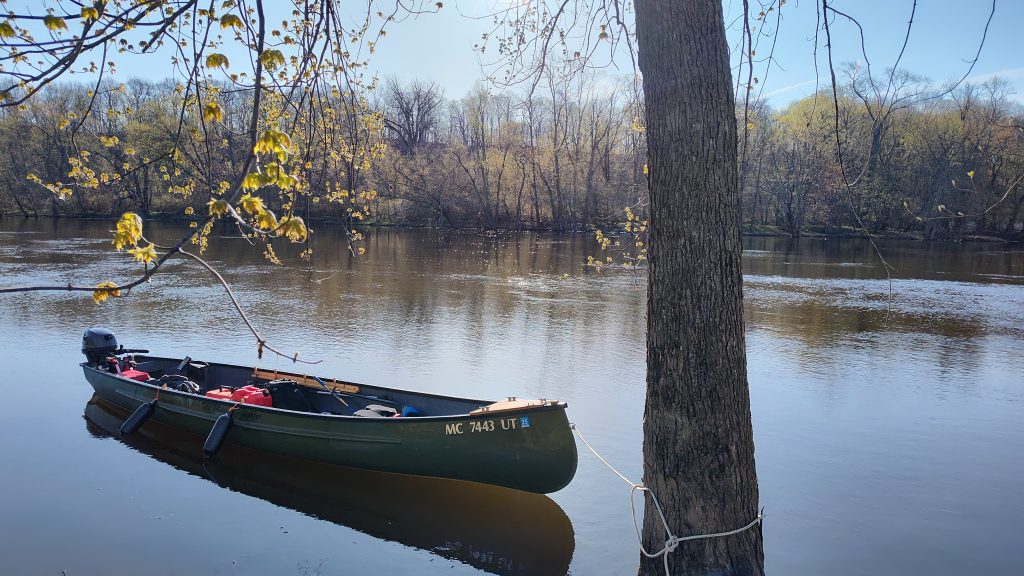
We had started our journey at Boynton Landing, known as Steamboat Park. This Jenison property has been in the Boynton family since 1836. The boisterous Boyntons run a campground, an airport and the riverboat, The Grand Lady!
The Grand Lady
The Boynton family had The Grand Lady built in the 1990’s, modeled after the riverboats from the previous century. For twenty years this excursion vessel had been docked in Grandville where the diesel powered riverboat would take passengers on a journey along The Grand River. The double paddle wheels have provided easier maneuverability along the narrow waterway.
Since 2011, The Grand Lady has been located at the Boynton property. It has continued to provide a glimpse into the past with live musical entertainment as people journey from Boynton’s Landing to Grand Haven and back.

for the chance to bring passengers for a memorable ride.
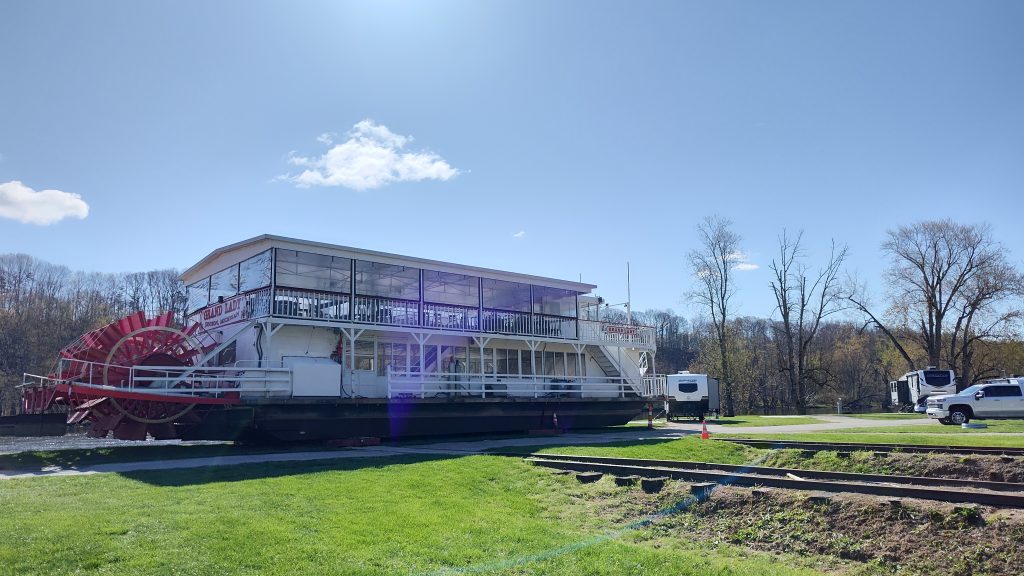
A Touch of Steamboat History
The first steamboat on The Grand River had been The Governor Mason built in 1837. Beginning on the 4th of July, this vessel carried freight and passengers from ‘The Rapids’ (Grand Rapids) to ‘The Haven on the Grand’ (Grand Haven). The boat hadn’t been equip with a whistle, so a bugler had been hired to announce their arrivals and departures.
The Owashtanong, Odawa name for the Grand River, had been the second steamboat built in “The Haven on the Grand” in 1837 by Robinson, White and Williams Co. This vessel had a whistle installed. The builder, Demetrius Turner, had claimed that it was the first steamboat whistle to be made west of Detroit. Turner had written, “I waited until we got well out of town before I tried it. We were down near the log school house a short distance downstream, and the children heard it and were afraid to go to school because they thought it was a panther howling in the woods.”
Although The Owashtanong had been mainly designed to haul freight, Henry Schoolcraft, an Indian Agent, had been aboard in June 1838 from ‘The Haven on the Grand’ to ‘The Rapids.’ Schoolcraft had been interviewing native tribes and learning about their culture. He had assembled his observations in a series of books.
The riverboat, John Almy, had caught my attention years ago. Orson Peck, the ship builder of the John Almy, had joined the crowded Lowell riverbank in 1838 to watch his ship’s maiden voyage from Grand Rapids to Lowell. Arriving at the confluence of The Grand River and The Flat River the John Almy had become grounded. Passengers were able to get safely ashore before the John Almy became waterlogged and sadly wrecked.
Waving Down A Steamboat
As we motored along The Grand we noticed a farmer plowing his field. It had reminded me of Bill Boynton’s tale. He had said people could flag down a passing steamboat by waving.

‘Next time bring me some tobacco and matches.‘ “
Landings
Landings, or settlements, began growing up along the river just like mushrooms growing overnight. Within a short span of time there had been two dozen developments along the banks of The Grand.
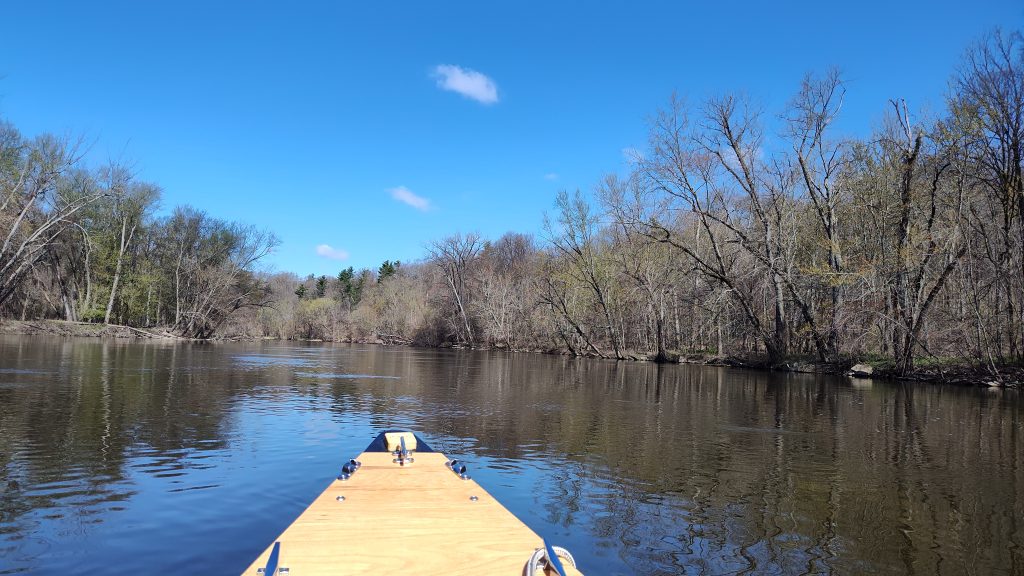
Haire Landing
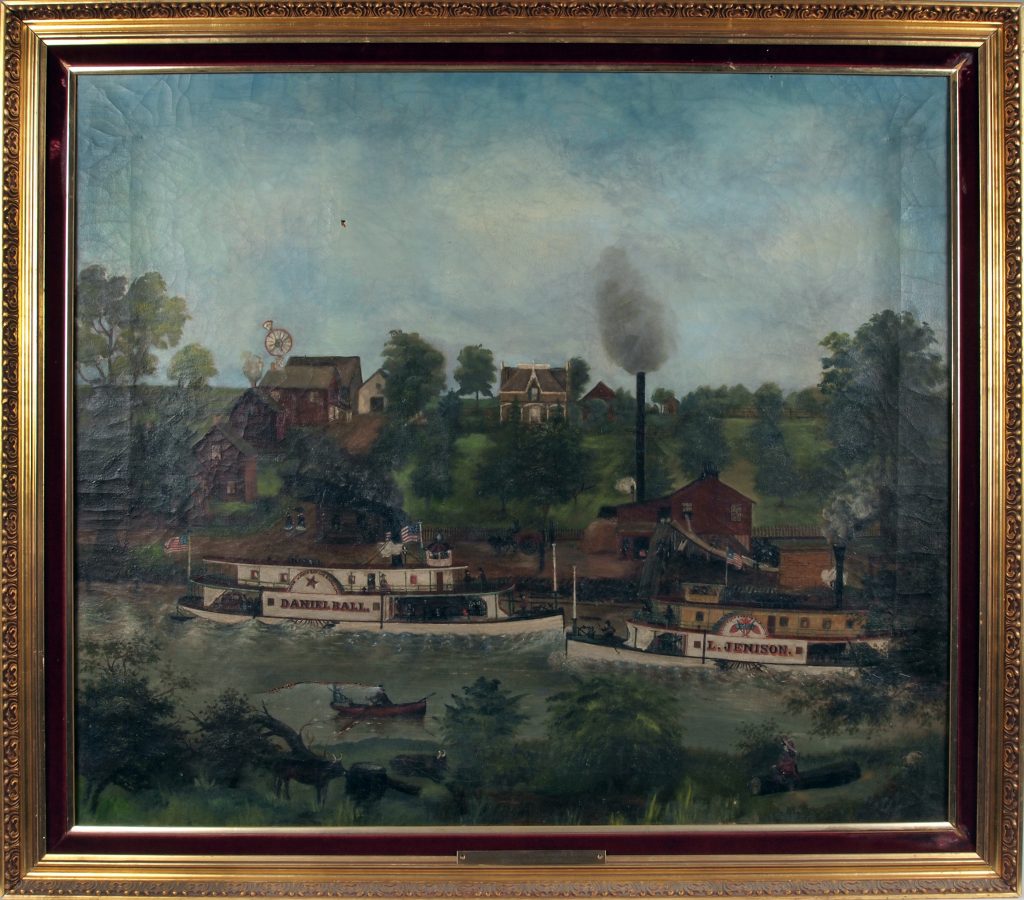
The settlers at Haire’s Landing had painted their buildings bright red. There had been a sawmill, blacksmith, a dry goods store, a boarding house and a school.
The Log Jam of 1883

Photo Credit: Grand Rapids Public Library
The logging industry had added to the economy as well as the challenges of the early settlers. Following two months of rain in 1883, logs had been carried downstream floating on the high water of The Grand River. Bridges had been destroyed by the powerful log jam as the massive blockade careened toward Lake Michigan. The economy would have been in shambles if the natural resource had been released into Lake Michigan! Workers set up their own blockade of booms crossing the river near “The Haven on the Grand” to prevent catastrophe. It had worked!
Boynton Landing
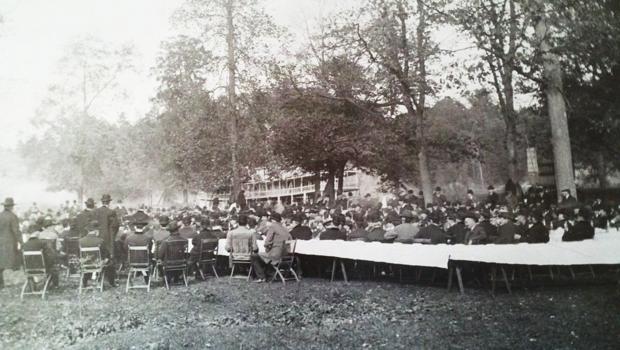
Photo Credit: MLive Article – Grand Rapids Historical Society
At the turn of the century, the speed and efficiency of the railroads being built had been putting a squeeze on the steamboat industry. The Boynton family had boosted their site by constructing a gazebo in 1906 creating ‘a destination’ to their already popular picnic location, known as ‘Church Grove” and “River Park.” With a fare of $0.25 round trip, they had been confident that their business would continue to be profitable.
However, they have had to continue to adjust to the times and grow with modern needs. Creating a beautiful campground and functional airport, the Boynton family serves their community. They also have storage facilities and farmland. The Grand Lady tours continue to be a popular event! We encourage you to take a ride on their riverboat!
Lowell’s Showboat
Another area vessel that has grown with the times is the Lowell Showboat. During the height of The Depression in 1932, Lowell officials had decided to lift the spirits of the community and entice visitors with the Lowell Showboat! Local and professional variety acts had lit up the stage of the Lowell Showboat for decades.
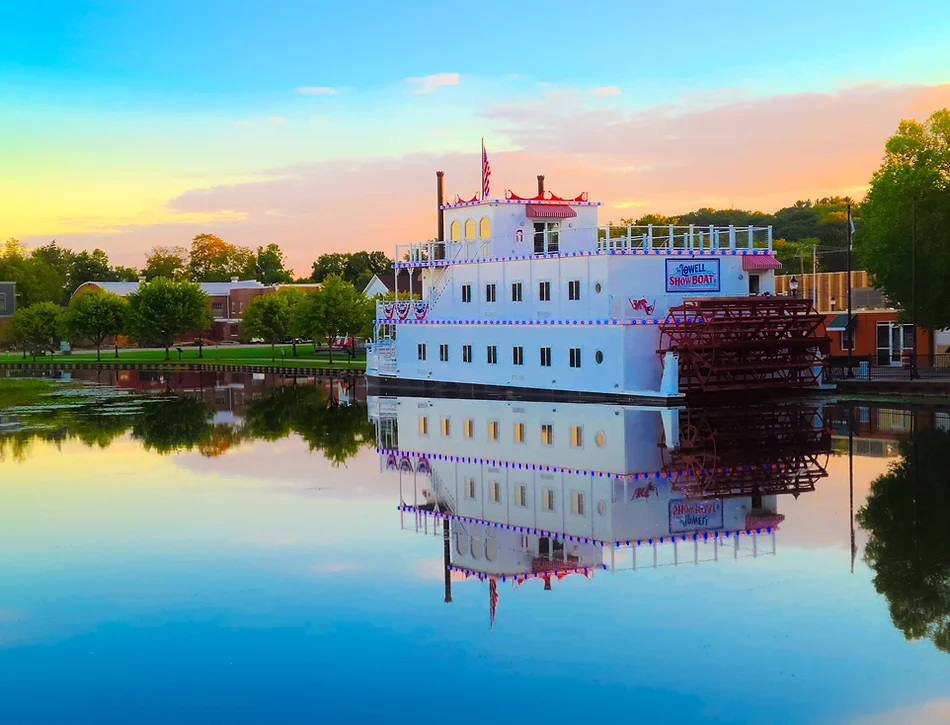
In the 1970’s I had been entertained by Vic Damone and The Smother Brothers. What a treat! Six showboats have graced the waters of The Flat River since the start during The Depression.
Each Thursday the Showboat tradition continues. Free community concerts are held in front of the Showboat on the lawn of the Englehart Kent District Library. These events are sponsored by Lowell Arts and The Chamber of Commerce. Adjusting to modern times, the latest Showboat is an event venue which can be rented for gatherings.
Water Quality
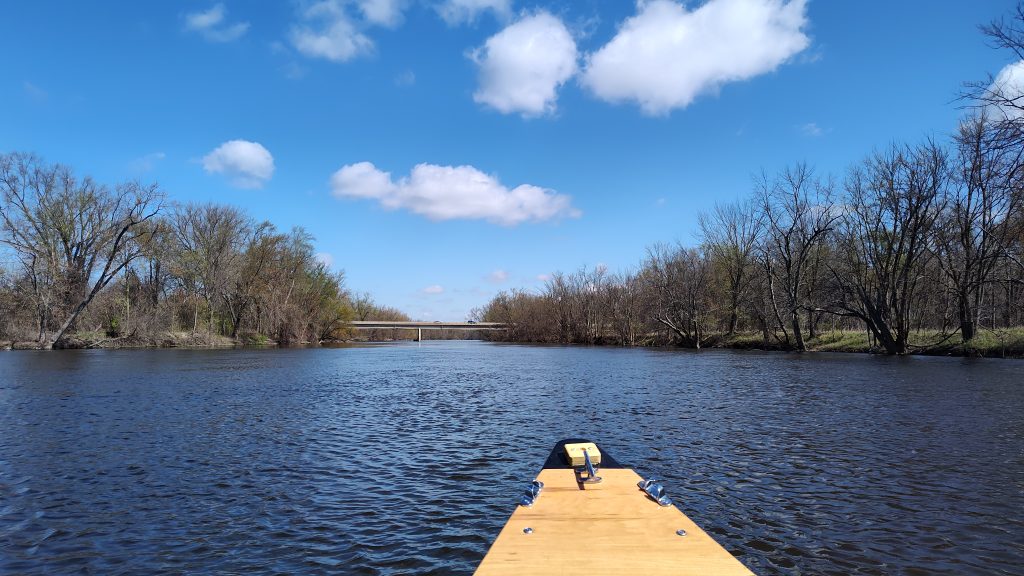
The Grand River quality has improved as people have become more conscientious and laws have been passed to ensure water quality.
Our Continued Journey
We continued to putter down the quiet river imagining the history that it had witnessed. I had been thankful that we had a motor to do the work. The effort it would have taken to paddle this distance would have been intense! Boy, do I admire the Anishinaabe as well as the early settlers!
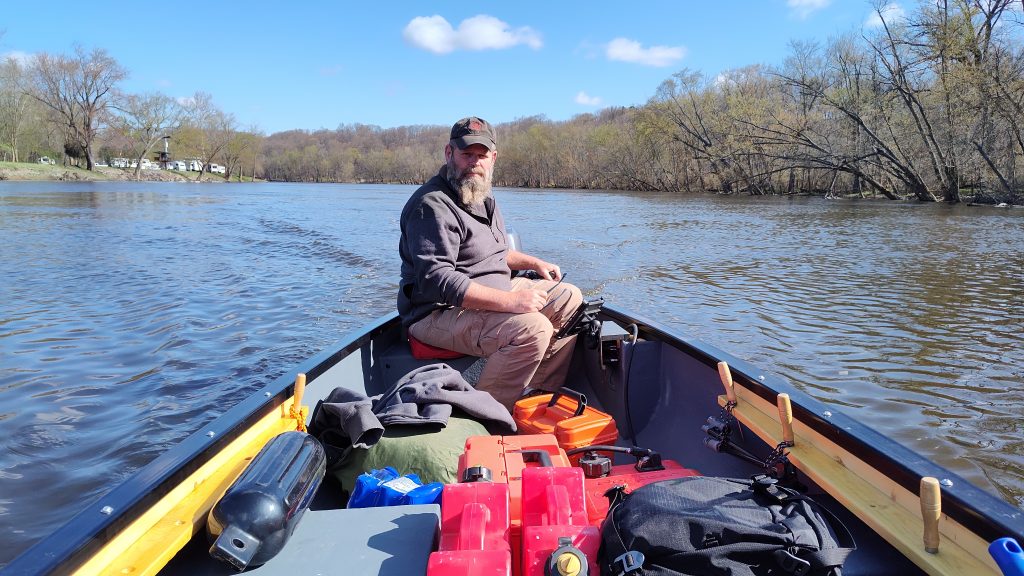
SNACKLE-box
Following our modern protocols, I’d brought along some treats to eat on our journey. I’ve always been known for providing snacks, drinks and treats!
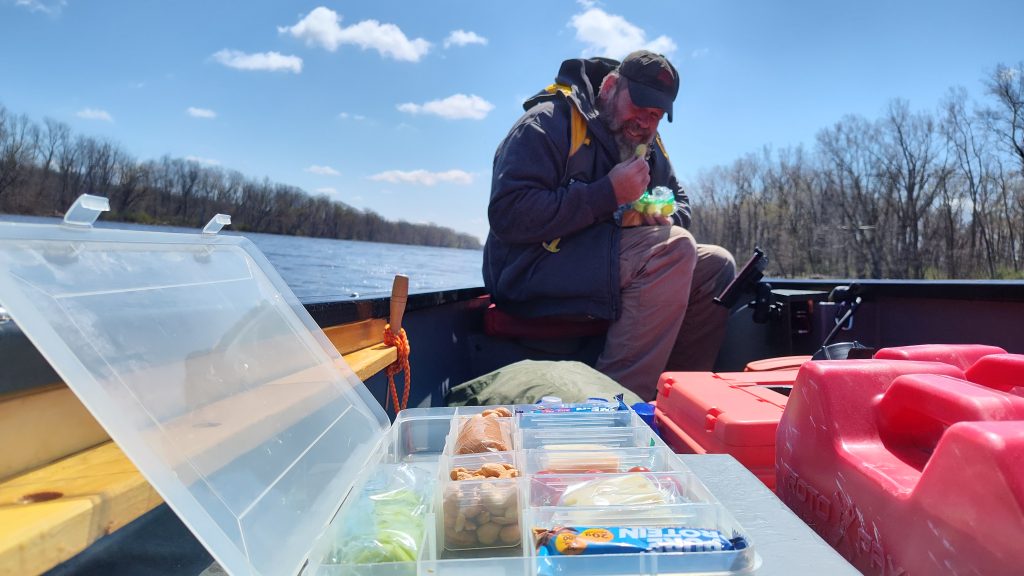
Hidden History and A Curious Future
The Grand River’s quiet presence holds hidden history along it’s banks. Transportation on the river had once been the easiest, smoothest method of moving goods and people. Then rail roads had sped up the pace of our lives along with the industrial revolution. The Grand River had a sad chapter of being used as a dump. Then, clean up efforts began in the late 1970’s.
The recovery of the water over the recent decades has built a healthy ecosystem along the 262 mile Grand River. Steps are currently being taken by the City of Grand Rapids to modify the dams in order to bring the rapids back to The Grand. Stay tuned to learn the future of our longest river in Michigan. Keep being curious, make memories and take a leap outside of your comfort zone!
Related Links:
Our Restless Viking YouTube video of our trip down The Grand!
“Canoeing Commute – Pondering History” Restless Viking article
“Lowell’s History Comes To Life” Restless Viking article
Resources:
Grand Rapids History website
The Grand Lady website
Steamboat Park Campground 825 Taylor St, Jenison, Michigan 49428
616-45RIVER / 616-457-4837
“Grand Rapids’ Last Riverboat” MLive article
“Steaming on The Grand” Free Library article
The Michigan Princess website
Heritage Water Trail Map
Wood TV article “1883: The Logjam That Nearly Sank Furniture City”
GVSU Anthropology Grand River Landings Findings
Lowell’s First Look “R is for Riverboat” article






One thought on “The Grand River – Longest Waterway in Michigan”
I had seen the Restless Viking video of this trip, but this article had even more interesting information. Good read!